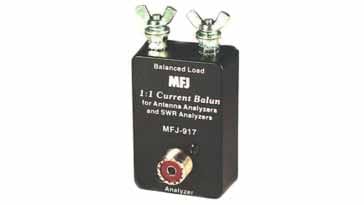What is an Antenna Current Balun / Choke Balun
Antenna current baluns or choke baluns provide a useful method of providing a balanced to unbalanced transformation for an antenna by placing a series impedance on the feed line.
Home » Antennas & Propagation » this page
RF Antenna Baluns & Ununs Includes:
Antenna Balun basics
Current balun
Unun basics
Current baluns are often also referred to as choke baluns and they different to the voltage baluns in that the current balun places a large series impedance on the outside of the unbalanced feeder (coaxial feeder).
This prevents the radio frequency currents from travelling along the outside of the feeder and giving rise to the unwanted effects this can cause.
Current baluns can be easier and more convenient to implement in many situations and accordingly they are used on many radio antenna systems.
Choke of current balun basics
One of the easiest methods of implementing a current balun is to use a coil of the coaxial feeder. The feeder can be coiled , bearing in mind its minimum bend radius, with a coil diameter of possibly 18 to 30 cm.
Often coil of around ten turns will provide a useful form of current balun for the HF bands.
There is a major drawback in terms of the performance of these simple coiled / choke baluns. They not only introduce inductance as a result of the coild coax, but there is also capacitance and as a result these baluns become resonant and accordingly there performance will only be optimum over a small bandwidth..
Ferrite based current baluns
In order to increase the inductance within the balun without there being too many turns, the coaxial cable is often wound on a ferrite toroid.

Winding the coaxial feeder on the ferrite toroid enables the inductance to be increased many folder (dependent upon the type of ferrite) without increasing the capacitance.
A typical example of an HF choke balun might be constructed from a length of coaxial cable which has been wound to give ten or twelve turns on a suitable ferrite core.
It is necessary to ensure that the coax is not wound too tightly on the ferrite toroid so that its damaged, however it will normally be wound more tightly that the bend radius specified in the specification for the coax cable recommends.
The toroid core will also need to be chosen so that it can handle the power. Even a 50 to 100 watt transmitter will need to use a toroid that can handle the required power level without overheating, etc.
The issue with overheating can be that the permeability of the ferrite might collapse and this would cause the balun to fail.
Current baluns are one of the easier types of balun to build and implement as they just consist of the coaxial feeder which is ideally wound on a ferrite toroidal core. Although many baluns are the voltage type that consist of a transformer, the current or choke balun finds many uses.
 Written by Ian Poole .
Written by Ian Poole .
Experienced electronics engineer and author.
More Antenna & Propagation Topics:
EM waves
Radio propagation
Ionospheric propagation
Ground wave
Meteor scatter
Tropospheric propagation
Antenna basics
Cubical quad
Dipole
Discone
Ferrite rod
Log periodic antenna
Parabolic reflector antenna
Phased array antennas
Vertical antennas
Yagi
Antenna grounding
Installation guidelines
TV antennas
Coax cable
Waveguide
VSWR
Antenna baluns
MIMO
Return to Antennas & Propagation menu . . .




